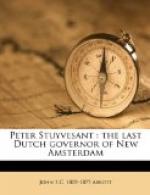Stuyvesant would allow nothing to be done which he did not control. The education of the young was greatly neglected. Jacob Corlaer opened a school. The governor peremptorily closed it, because he had presumed to take the office without governmental permission. To establish a place of amusement the governor formed a village called Haarlem, at the northern extremity of Manhattan island. He also constructed a good road over the island, through the forest, “so that it may be made easy to come hither, and return to that village on horseback or in a wagon.” A ferry was also established to Long Island.
Staten Island was a dreary waste. It had not recovered from the massacre of 1655. Efforts were made to encourage the former settlers to return to their desolated homes, and to encourage fresh colonists to take up their residence upon the island. To promote the settlement of the west side of the North river, Stuyvesant purchased from the Indians, all the territory now known as Bergen, in New Jersey.
This purchase comprised the extensive region,
“beginning from the great rock above Wiehackan, and from there right through the land, until above the island Sikakes, and from there to the Kill van Col, and so along to the Constables Hook, and thence again to the rock above Wiehackan.”
The settlement at Esopus, was in many respects in a flourishing condition. But it was so much more convenient for the farmers to have their dwellings in the midst of the fields they cultivated, instead of clustering them together in a compact village, that they persisted in the dangerous practice, notwithstanding all the warnings of the governor. There were individuals also who could not be restrained from paying brandy to the savages for their peltries The intoxicated Indians often committed outrages. One of the settlers was killed. The house and outbuildings of another were burned. The Dutch retaliated by destroying the cornfields of the Indians, hoping thus to drive them to a distance. At this time, in May, 1658, there were about seventy colonists at Esopus. They had widely extended fields of grain. But the Indians were becoming daily more inimical, and the alarmed colonists wrote to Govern or Stuyvesant, saying,
“We pray you to send forty or fifty soldiers to save Esopus, which, if well settled, might supply the whole of New Netherland with provisions.”
The governor ordered a redoubt to be built at Esopus, sent an additional supply of ammunition, and taking fifty soldiers with him, went up the river to ascertain, by a personal investigation, the wants of the people. He urged them strenuously to unite in a village, which could be easily palisaded, and which would thus afford them complete protection. The colonists objected that it would be very difficult to remove from their farms, while their crops were ungathered, and that it would be impossible to select a site for the village which would please all. The governor refused to leave the soldiers with them unless they would immediately decide to concentrate in a village. In that case he would remain and aid them in constructing the palisade till it should be completed.




